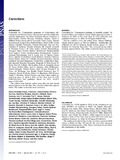Mostrar el registro sencillo del ítem
Comparative genomics of Ceriporiopsis subvermispora and Phanerochaete chrysosporium provide insight into selective ligninolysis
| dc.creator | Fernández Fueyo, Elena | es_ES |
| dc.creator | Ruiz Dueñas, Francisco J. | es_ES |
| dc.creator | Ferreira, Patricia | es_ES |
| dc.creator | Floudas, Dimitrios | es_ES |
| dc.creator | Lavín Trueba, José Luis | es_ES |
| dc.creator | Oguiza Tomé, José Antonio | es_ES |
| dc.creator | Pérez Garrido, María Gumersinda | es_ES |
| dc.creator | Pisabarro de Lucas, Gerardo | es_ES |
| dc.creator | Ramírez Nasto, Lucía | es_ES |
| dc.creator | Santoyo Santos, Francisco | es_ES |
| dc.date.accessioned | 2018-12-28T09:14:05Z | |
| dc.date.available | 2018-12-28T09:14:05Z | |
| dc.date.issued | 2012 | |
| dc.identifier.issn | 0027-8424 (Print) | |
| dc.identifier.issn | 1091-6490 (Electronic) | |
| dc.identifier.uri | https://hdl.handle.net/2454/31886 | |
| dc.description.abstract | Efficient lignin depolymerization is unique to the wood decay basidiomycetes, collectively referred to as white rot fungi. Phanerochaete chrysosporium simultaneously degrades lignin and cellulose, whereas the closely related species, Ceriporiopsis subvermispora, also depolymerizes lignin but may do so with relatively little cellulose degradation. To investigate the basis for selective ligninolysis, we conducted comparative genome analysis of C. subvermispora and P. chrysosporium. Genes encoding manganese peroxidase numbered 13 and five in C. subvermispora and P. chrysosporium, respectively. In addition, the C. subvermispora genome contains at least seven genes predicted to encode laccases, whereas the P. chrysosporium genome contains none. We also observed expansion of the number of C. subvermispora desaturase-encoding genes putatively involved in lipid metabolism. Microarray-based transcriptome analysis showed substantial up-regulation of several desaturase and MnP genes in wood-containing medium. MS identified MnP proteins in C. subvermispora culture filtrates, but none in P. chrysosporium cultures. These results support the importance of MnP and a lignin degradation mechanism whereby cleavage of the dominant nonphenolic structures is mediated by lipid peroxidation products. Two C. subvermispora genes were predicted to encode peroxidases structurally similar to P. chrysosporium lignin peroxidase and, following heterologous expression in Escherichia coli, the enzymes were shown to oxidize high redox potential substrates, but not Mn2+. Apart from oxidative lignin degradation, we also examined cellulolytic and hemicellulolytic systems in both fungi. In summary, the C. subvermispora genetic inventory and expression patterns exhibit increased oxidoreductase potential and diminished cellulolytic capability relative to P. chrysosporium. | en |
| dc.description.sponsorship | The major portions of this work were performed under US Department of Agriculture Cooperative State, Research, Education, and Extension Service Grant 2007-35504-18257 (to D.C. and R.A.B.). The US Department of Energy Joint Genome Institute is supported by the Office of Science of the US Department of Energy under Contract DE-AC02-05CH11231. This work was supported by Spanish Projects BIO2008-01533 and BIO2011-26694, European Project Peroxidases as Biocatalysts KBBE-2010-4-265397 (to F.J.R.-D. and A.T.M.), the Chilean National Fund for Scientific and Technological Development Grant 1090513 (to L.F.L.), and a “Ramon y Cajal” contract (to F.J.R.-D.). | en |
| dc.format.extent | 8 p. | |
| dc.format.mimetype | application/pdf | en |
| dc.format.mimetype | application/zip | en |
| dc.language.iso | eng | en |
| dc.publisher | National Academy of Sciences | en |
| dc.relation.ispartof | PNAS, April 3, 2012 109 (14) 5458-5463 | en |
| dc.subject | Ceriporiopsis subvermispora | en |
| dc.subject | Phanerochaete chrysosporium | en |
| dc.subject | Selective ligninolysis | en |
| dc.title | Comparative genomics of Ceriporiopsis subvermispora and Phanerochaete chrysosporium provide insight into selective ligninolysis | en |
| dc.type | info:eu-repo/semantics/article | en |
| dc.type | Artículo / Artikulua | es |
| dc.contributor.department | Producción Agraria | es_ES |
| dc.contributor.department | Nekazaritza Ekoizpena | eu |
| dc.rights.accessRights | info:eu-repo/semantics/openAccess | en |
| dc.rights.accessRights | Acceso abierto / Sarbide irekia | es |
| dc.identifier.doi | 10.1073/pnas.1119912109 | |
| dc.relation.projectID | info:eu-repo/grantAgreement/MICINN//BIO2011-26694/ES/ | en |
| dc.relation.publisherversion | https://doi.org/10.1073/pnas.1119912109 | |
| dc.type.version | info:eu-repo/semantics/publishedVersion | en |
| dc.type.version | Versión publicada / Argitaratu den bertsioa | es |


